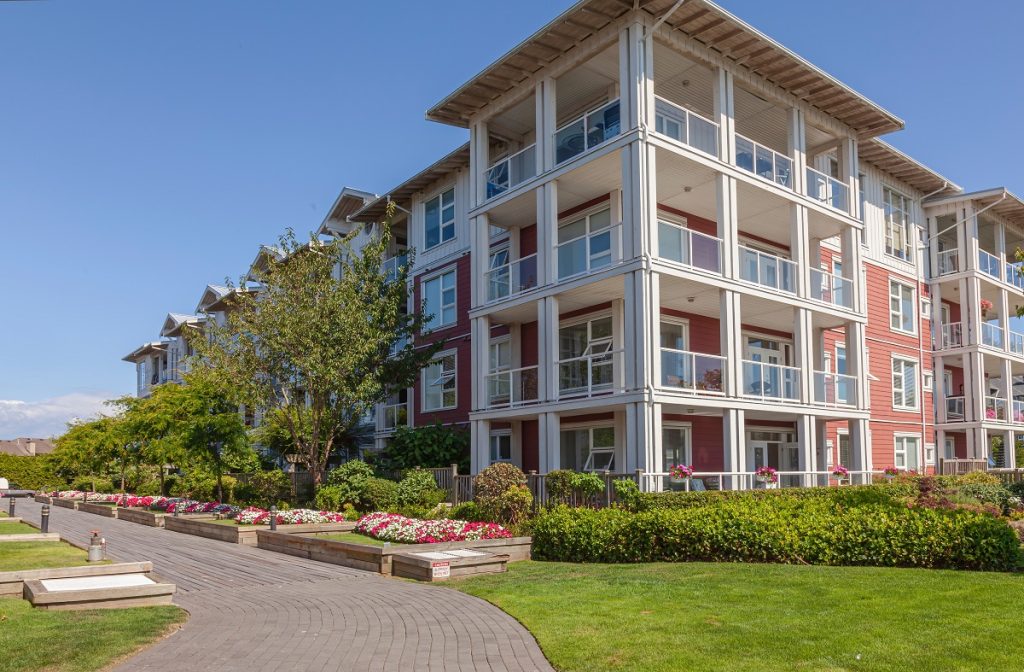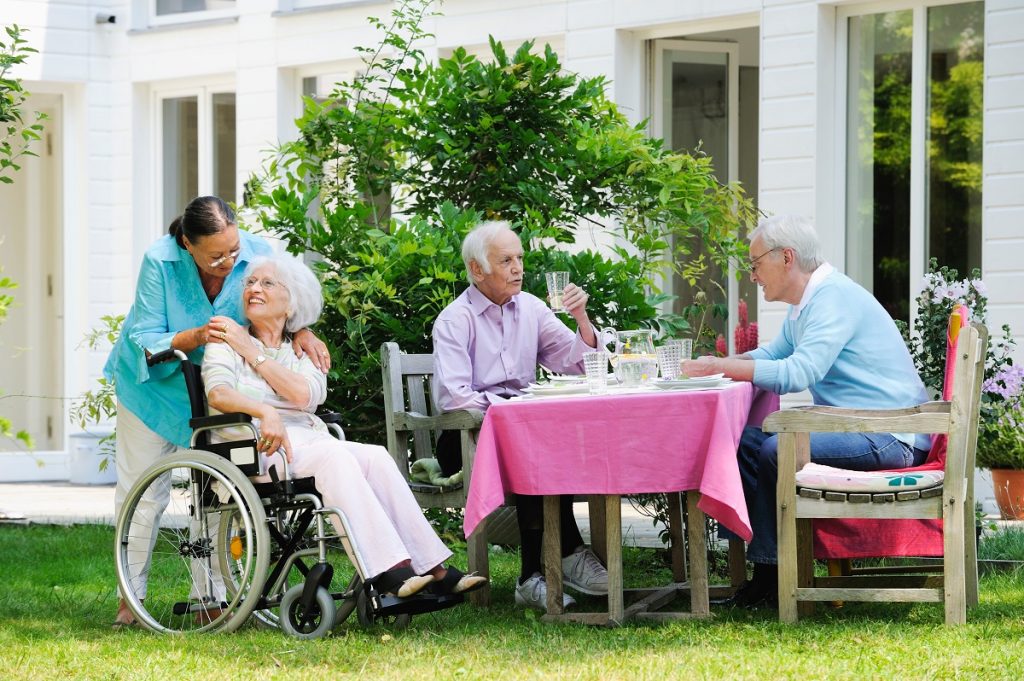Senior living apartments are apartments, townhomes, and condos located within communities or complexes specifically designed with the wants and needs of older adults in mind. They may have age restrictions, including laundry, housekeeping services, and on-site amenities. They are one type of senior housing.
Senior apartments are typically residential units specifically designed and marketed for older adults, typically 55 years of age and older. They may offer amenities and services tailored to the needs of your loved ones, such as safety features, social activities, and transportation assistance. However, medical care is not typically available.
These apartments may also have age-restricted occupancy policies, meaning that only individuals who meet the age requirement can live in the building.
Is There A Difference Between Senior Housing And Senior Apartments?
Senior housing generally refers to any housing or senior living community specifically designed and marketed for older adults. This can include various housing options, such as independent living communities, assisted living facilities, nursing homes, and continuing care retirement communities (CCRCs). These final two options sometimes include facilities for memory care, e.g., for residents with Alzheimer’s)
On the other hand, senior apartments are residential units rented or leased monthly. They are often age-restricted, meaning that only individuals who meet the age requirement (usually 55 years or older) can live in the building. They typically offer amenities and services tailored to the needs of older adults, such as safety features, social activities, and transportation assistance.

In summary, senior housing is a broader term that encompasses various housing options for seniors, while senior apartments refer to a specific type of rental housing for older adults.
Stand-Alone Apartments
Seniors can live independently in stand-alone apartments, some of which are marketed as “senior apartments.” These apartments can be a good option for seniors who are relatively independent, healthy, and able to care for themselves. They may also be a more affordable option for older adults on a fixed income or those looking to live in a more basic, low-maintenance environment.
Depending on the price, these apartments may or may not have amenities such as a fitness center, community room, or on-site staff and may not offer meal delivery or transportation assistance services. Many have activities that appeal to seniors.
These apartments can be a good option for seniors who are relatively independent, healthy, and able to care for themselves. They may also be a more affordable option for older adults on a fixed income or those looking to live in a more basic, low-maintenance environment.
Unfortunately, they may not have safety features such as grab bars, emergency call systems, or other assistive technology that can help seniors with mobility or other health issues. They also may not have staff or care services on-site to assist in an emergency.
Living in a stand-alone apartment with minimal amenities can offer a sense of privacy, freedom, and a chance to live in a quiet, peaceful environment. They can be a good option for someone in decent health or who has someone to look after their ongoing well-being.
Affording Senior Housing
Social Security
Social Security is a federal program that provides retirement, survivor, and disability benefits to eligible individuals. Some older adults may use their Social Security benefits to help pay for senior housing. Still, it’s important to note that the benefits provided by the program may not be enough to cover the full cost of housing.
Ideally, a senior will have other pensions plus investments and savings to finance retirement living. Some may continue to work at full or part-time jobs to support themselves.
Medicare And Senior Housing
Medicare is a federal health insurance provider for people 65 or older, people with specific disabilities, and people with End-Stage Renal Disease. It does not provide coverage for long-term care services or senior housing.
Medicare covers certain aspects of senior care, including hospital treatment, doctors, and preventive services. It does not cover custodial care, which includes help with activities of daily living such as bathing, dressing, and eating. Therefore, it doesn’t cover the costs associated with senior housing, assisted living, or skilled nursing homes.
The program does cover residency in a short-term rehabilitation facility when someone needs custodial and medical care after a stroke, surgery, or accident. Medicare only pays for the first 100 days of any occurrence, so it cannot be considered a payment method for housing.
On the other hand, Medicaid pays for nursing home care for those who qualify based on income and health conditions requiring nursing home-level care. Neither program pays for independent senior living or options such as assisted living.
Low-Income Housing For Seniors
Low-income housing for seniors refers to affordable housing options specifically designed and marketed for older adults with low to moderate incomes. The government usually subsidizes these housing options, designed to provide affordable rental housing for seniors who cannot afford market-rate housing.

The U.S. Department of Housing and Urban Development (HUD) is a federal agency that offers a variety of programs to help older adults access affordable housing. Some of the senior housing programs offered by HUD include:
- Public housing: This is owned and operated by a government agency and is available to low-income individuals and families.
- Section 202 housing: This is a federal program that provides funding for the construction and operation of housing for seniors with low incomes.
- Section 8 housing: This federal program provides vouchers to low-income families, seniors, and individuals to help them afford the monthly rent in the private market.
- Low-income tax credit properties: These are private properties developed with funding from the Low-Income Housing Tax Credit program, which provides tax incentives to developers who build and maintain affordable housing.
These housing options may have specific eligibility requirements, such as income limits, age restrictions, and other criteria that vary based on the program.
It’s worth noting that waiting lists for low-income housing can be long, and there may not be enough units for everyone who needs them.
What Is The Cheapest Way For A Senior To Live?
There are several ways for seniors to live on a budget, including:
- Downsizing to a smaller home or apartment: By significantly reducing housing costs, seniors can free up some extra cash for other expenses.
- Renting instead of owning: Renting can be a more affordable option for seniors, as it eliminates the need for mortgage payments, property taxes, and maintenance costs.
- Living in low-income or subsidized housing: Low-income or subsidized housing can be a more affordable option for seniors with limited incomes as they may only have to pay 30% of their income, even if the market value rent is higher. These options may have specific eligibility requirements, such as income limits, age restrictions, and other criteria that vary based on the program.
- Moving to a cheaper area: Moving to a city or region with a lower cost of living can significantly reduce expenses related to housing, food, and other necessities.
- Sharing a home with other seniors: Sharing a home with other seniors, children, or roommates can also be a cost-effective option as it can help to split the cost of housing and other expenses.
- Participating in local programs for seniors: Many communities have programs that provide assistance and resources for seniors, such as meals on wheels, transportation services, and volunteer programs.
- Reducing unnecessary expenses: Reviewing your spending habits and cutting back on unnecessary costs can help to free up more money for housing and other essentials.
These options may not be suitable for everyone, and you must consider personal preferences, health and safety needs, and other factors when deciding.

What Are The Benefits Of Senior Apartments?
Senior apartments offer a variety of benefits for older adults, including:
- Age-restricted communities: Senior apartments are typically age-restricted, which means that only individuals who meet the age requirement (usually 55 years or older) are allowed to live in the building. They can provide community and camaraderie among residents with similar life experiences and interests.
- Safety and security: Many senior apartments have safety features such as grab bars, emergency call systems, and other assistive technology that can help seniors with mobility or other health issues.
- Maintenance-free living. The staff takes care of the upkeep and repairs of the building, grounds, and common areas.
- Social activities and events: Many senior apartments have social activities and events that provide opportunities for residents to socialize and stay active.
- Transportation assistance: Some senior apartments offer transportation assistance, such as shuttles or vans, to help residents get to appointments, shopping, and other destinations.
- Affordable housing: Senior apartments can be more affordable than other housing types, especially for older adults on a fixed income.
- Convenience: Many senior apartments are located near shopping centers, medical facilities, and other important amenities for older adults.
- Sense of community: Living in a senior apartment can provide a sense of community and belonging among older adults with similar life experiences and interests.

Which State Has The Cheapest Senior Apartments?
The cost of senior apartments can vary depending on location. The cheapest state for senior apartments can change based on housing market conditions and the local cost of living.
According to data from the National Low Income Housing Coalition, states such as Alabama, Arkansas, Kentucky, Mississippi, and West Virginia have some of the lowest median rents for one-bedroom apartments in the country. These states have relatively low costs of living, and the median rents for one-bedroom apartments are generally lower than in other states.
It’s important to note that these states may not have as many senior apartments available as other states, and availability and quality of services may vary between different senior apartments.
Local non-profit organizations, Area Agencies on Aging, and government websites offer more information on senior housing options and costs in a specific area.
Genworth’s website can also provide figures on the cost of senior living.
How Much Are Senior Apartments In Florida?
The Sunshine State is the retirement capital of the U.S. and has 20% of its population under 65. Only California has more senior residents. How much do apartment options cost there?

How Much Is A Senior Apartment In Florida?
The cost of a senior apartment in Florida depends on the location, size of the unit, and the amenities and services offered. According to data from the National Low Income Housing Coalition, the average fair market rent for a one-bedroom apartment in Florida is $1,094 as of 2021.
Cities such as Miami, Tampa, and Orlando tend to have higher median rents than more rural areas. Additionally, senior apartments in Florida can vary in terms of the services and amenities they offer, and prices may reflect the level of care and services provided.
Some senior apartments in Florida may be subsidized by the government or non-profit organizations, making them more affordable for older adults on a fixed income.
What Is The Average Starting Rent For A Studio Apartment In Florida?
The average starting rent for a studio apartment in Florida can vary depending on location, the amenities and services offered, and the time of the year. However, According to data from the National Low Income Housing Coalition, the average fair market rent for a studio apartment in Florida is $931 as of 2021.
It’s also important to note that rents can fluctuate depending on the time of the year, with prices often higher during peak tourist seasons.
Where Are The Cheapest 55+ Communities In Florida?
Some of the areas in Florida that tend to have lower median home prices and cost of living include:
- The Panhandle: Cities like Pensacola, Tallahassee, and Panama City have relatively low living costs and lower median home prices compared to other parts of the state.
- North Central Florida: Gainesville and Ocala have lower median home prices and cost of living than larger cities like Orlando and Miami.
- The Nature Coast: Cities like Homosassa and Crystal River offer a more rural lifestyle, with lower living costs and home prices.
It’s important to note that while these areas may have lower average costs of living and home prices, they may not have as many 55+ communities available or as many amenities and services as other areas in Florida.

What Are The Cheapest Senior Apartments In Florida?
The cheapest senior apartments in Florida can vary in size, amenities, and services. However, in general, they may have the following characteristics:
- Smaller floor plans: Cheaper senior apartments may be smaller than more expensive options, such as studios or one-bedroom apartments.
- Limited amenities: Cheaper senior apartments may have limited amenities compared to more expensive options, such as a swimming pool, fitness center, or community room.
- Basic services: Cheaper senior apartments may offer basic services such as on-site maintenance and laundry facilities but may not have additional services such as meal delivery or transportation assistance.
- Older buildings: Cheaper senior apartments may be located in older buildings that have been repurposed as senior housing rather than newer constructions.
- Older appliances and furnishings: Cheaper senior apartments may have older devices and furnishings, which can be less expensive to maintain but may not be as modern or updated as more costly options.
It’s important to note that while these apartments may be more affordable, they may not have the same safety features. These items, such as grab bars, emergency call systems, or other assistive technology, can help seniors with mobility or other health issues. Additionally, these apartments may not have staff on-site to assist in an emergency.
How Do You Qualify For Low-Income Senior Housing In Florida?
Qualifying for low-income senior housing in Florida typically involves meeting certain income and age requirements and other criteria, which can vary depending on the program or housing development.
- Income requirements: Low-income senior housing is typically available to older adults with an income at or below a certain level (usually set at or below 60% of the area median income). This means that the older adult’s income should not exceed a certain amount to be eligible.
- Age requirements: Low-income senior housing is generally available to older adults 55 years or older.
- Residency: Low-income senior housing is usually available to residents of the state or local area where the housing development is located.
- Other criteria, such as criminal background or credit history. Some low-income senior housing may also have specific requirements or preferences, such as veterans or people with disabilities.
The eligibility requirements for low-income senior housing can vary depending on the specific program or housing development, and it’s always recommended to check with the particular program or housing development for more information on their specific requirements.
Check with local non-profit organizations, Area Agencies on Aging, and government websites for more information on Florida senior housing options and costs.
Additionally, searching online on apartment rental websites or contacting apartment communities directly can also estimate the cost of living in 55+ communities in a specific area.

